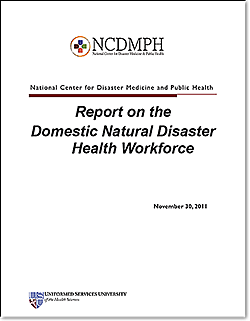 The National Center for Disaster Medicine and Public Health - ncdmph.usuhs.edu - February 1, 2012
The National Center for Disaster Medicine and Public Health - ncdmph.usuhs.edu - February 1, 2012
Greetings NCDMPH Stakeholders,
The NCDMPH is extremely proud to release the Report on the Domestic Natural Disaster Health Workforce, a landscape analysis describing selected aspects of the health professions workforce who would respond to a catastrophic domestic natural disaster.
As the main output of our workforce project, the report analyzes the core Federal departments supporting Emergency Support Function #8 (ESF#8) by examining three key occupational sub-groups (emergency and critical care physicians, emergency and critical care nurses, and paramedics) at the national, state and local levels.
The report offers 14 recommendations on a number of issues, including: double counting of responders, volunteer failure to respond, an aging medical workforce, human capital development, personnel asset visibility, readiness and the deployment of subunits.
Recent Comments